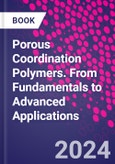Porous Coordination Polymers: From Fundamentals to Advanced Applications offers a comprehensive coverage the latest advances in porous coordination polymers for cutting-edge applications. Porous Coordination Polymers are gaining increasing interest due to their attractive properties, such as structural flexibility, large surface area, tailorable pore size, and functional tunability, in turn enabling a wide range of possible applications which this book aims to highlight and to elucidate.
The book begins by introducing porous coordination polymers, highlighting their structure, chemistry, basic properties, and design approaches. This is followed by a chapter focusing on synthetic methods and mechanical properties. Subsequent chapters provide in-depth coverage of specific target applications, explaining the preparation of porous coordination polymers for areas including catalysis and photocatalysis, environmental remediation, gas storage and separation, energy storage and conversion, new generation magnets, nanocarriers in therapeutics, and biomedical imaging. Finally, current challenges and future developments are considered in detail.
Please Note: This is an On Demand product, delivery may take up to 11 working days after payment has been received.
Table of Contents
- Porous coordination polymers: A brief Introduction.
- Approaches towards the synthesis and mechanical properties of porous coordination polymers.
- Progressive approach of porous coordination polymers towards catalysis and photocatalysis.
- Role of porous coordination polymers as chemical and biosensors in the remediation of environmental contaminants.
- Magnetic nano-composite of sugarcane bagasse/HKUST-1 for pesticides removal.
- Investigation of porous coordination polymers for gas storage and separation.
- 7.New advanced approach of ultra-fast synthesis of ultrahigh-BET-surface area crystalline/non-crystalline porous coordinated polymers.
- Porous Coordination Polymers in energy storage and conversion.
- Ions and electron conductive porous coordination polymers for energy applications.
- Conductive properties of triphenylene porous coordination polymers.
- Development of new generation magnets based on porous coordination polymers.
- Importance of porous coordination polymers as nanocarriers in therapeutics.
- Potentiality of nanoscale coordination polymers in biomedical imaging.
- Future prospects and grand challenges for porous coordination polymers.
Authors
Nidhi Goel Assistant Professor, Department of Chemistry, Institute of Science, Banaras Hindu University, Uttar Pradesh, India.Dr. Nidhi Goel received her doctorate in Chemistry, Indian Institute of Technology Roorkee, India. After postdoctoral research from Indian Institute of Science Bangalore, Karnataka, India, she started her independent academic career as Assistant Professor, Department of Chemistry, Institute of Science, Banaras Hindu University, Varanasi, India. Her research focuses on developing strategies, based on supramolecular building approaches, for rational construction of functional coordination polymers, Metal-Organic Frameworks and their prospective uses include magnetic, luminescence, and sensing applications. She is also working on drug design, medicinal chemistry natural products chemistry, and chemical biology. Dr. Goel has published more than fifty peer-reviewed research papers and book chapters in reputed international journals and books. She has 15 years research experience along with six years teaching experience at UG and PG level. She has been the Principal Investigator on three research projects from the Government of India. She is also a regular reviewer of a variety of international journals, and has also received several prestigious fellowships and research awards. Moreover, Dr. Goel is editing several books in CRC press Taylor & Francis group, Springer, and Elsevier. She is also acting as Guest Associate Editor in reputed journals.
Ki-Hyun Kim Professor, Air Quality and Materials Application Lab, Department of Civil and Environmental Engineering, Hanyang University, Korea.Prof. Ki-Hyun Kim, Ph.D., is a Professor based at the Air Quality and Materials Application Lab, in the Department of Civil and Environmental Engineering, Hanyang University, Korea. His research areas cover various aspects of research incorporating Air Quality & Environmental Engineering into Material Engineering, with an emphasis on advanced novel materials such as Metal-Organic Frameworks (MOFs). Prof. Kim was named as one of the top 10 National Star Faculties in Korea in 2006 and became an Academician of the Korean Academy of Science and Technology in 2018. He was recognized as 'Highly Cited Researcher (HCR)' for 2019 and 2020 in the Environment & Ecology field by Clarivate Analytics. He currently serves as associate editor of Environmental Research, Sensors, and Critical Reviews in Environmental Science & Technology, and has published more than 840 articles, many in leading scientific journals.








